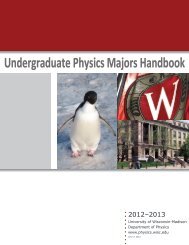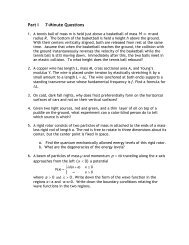Least Squares Fitting and Equation Solving with MPFIT
Least Squares Fitting and Equation Solving with MPFIT
Least Squares Fitting and Equation Solving with MPFIT
Create successful ePaper yourself
Turn your PDF publications into a flip-book with our unique Google optimized e-Paper software.
<strong>Least</strong> <strong>Squares</strong> Fi-ng <strong>and</strong><br />
Equa2on <strong>Solving</strong> <strong>with</strong> <strong>MPFIT</strong><br />
Craig Markwardt<br />
University of Maryl<strong>and</strong> <strong>and</strong><br />
NASA’s Goddard Spaceflight Center<br />
h>p://purl.com/net/mpfit<br />
2009‐04‐15
Data <strong>and</strong> Modeling<br />
• <strong>Least</strong> squares fiOng<br />
• Act of hypothesis tesPng<br />
• Simple Hypothesis:<br />
– data {x i , y i } are consistent <strong>with</strong> model f(x i ,p) to<br />
<strong>with</strong>in the measurement uncertainPes σ i<br />
– where {x i } is the independent variable <strong>and</strong> {y i } is<br />
the dependent variable<br />
– f(x i ,p) is the model funcPon, which is<br />
parameterized by parameters p
FiOng Example<br />
Model<br />
Data Values
We O_en “Know” When a Fit is Bad …
… because the Residuals are Large<br />
Residuals r i =<br />
Data ‐ Model
Summary<br />
• At its basic level a “good fit” should minimize<br />
the residuals, r i , between the data <strong>and</strong> model<br />
• To balance the measurements <strong>with</strong> large <strong>and</strong><br />
small uncertainty appropriately, our “scaled”<br />
residual looks like this,<br />
“residual”<br />
“data”<br />
r i = y i − f(x i ,p)<br />
σ i<br />
“model”<br />
“measurement<br />
uncertainty”
• In an ideal world, we would want a perfect<br />
match between data <strong>and</strong> model, i.e. solve the<br />
following equaPons simultaneously for M data<br />
points:<br />
r 0 = 0<br />
r 1 = 0<br />
...<br />
r M = 0
In PracPce this is not possible because of measurement noise…
• Instead we solve the system of equaPons in a<br />
“least squares” sense<br />
• Define the chi‐square staPsPc as the sum of<br />
the squared residuals,<br />
χ 2 =<br />
M∑<br />
i=1<br />
<strong>and</strong> minimize this staPsPc.<br />
r 2 i
StaPsPcal Background<br />
• The chi‐square staPsPc is important <strong>and</strong> well<br />
known<br />
• For gaussian staPsPcs, chi‐square minimizaPon<br />
should be equivalent to the maximum likelihood<br />
parameter esPmate<br />
• In the real world, an opPmal chi‐square value<br />
χ 2 ∼ M<br />
each data point contributes one degree of<br />
freedom.
Chi‐Square Test<br />
• Good fit:<br />
χ 2 ∼ 19.9<br />
for 20 data points<br />
• Bad fit:<br />
χ 2 ∼ 756<br />
for 20 data points
ExisPng FiOng Tools in IDL<br />
• General non‐linear:<br />
– CURVEFIT – Bevington algorithm (vectorized)<br />
– LMFIT – Numerical recipes (not vectorized)<br />
• Specialized:<br />
– LINFIT – linear (y = ax + b)<br />
– POLY_FIT – polynomial<br />
– SVDFIT – linear combinaPons<br />
– GAUSSFIT – peak fiOng
Introducing <strong>MPFIT</strong><br />
• Powerful fiOng engine based on MINPACK‐1<br />
(Moré <strong>and</strong> collaborators; h>p://netlib.org/minpack/)<br />
• Robust factorizaPon <strong>and</strong> stepping algorithms<br />
• InnovaPons:<br />
– Private data to user funcPons (FUNCTARGS)<br />
– Parameter upper <strong>and</strong> lower bounds (PARINFO)<br />
– User chooses who computes derivaPves<br />
– Control over iteraPon, console output, stopping<br />
tolerances
• <strong>MPFIT</strong> is the main fiOng engine, can solve any<br />
chi‐square minimizaPon problem expressable as<br />
min<br />
p<br />
M<br />
∑<br />
i=1<br />
r i (p) 2<br />
• Classic least squares fiOng looks like this,<br />
r i (p) = y i − f(x i ,p)<br />
σ i<br />
but we will warp this to other uses later.<br />
Dimensionality of x or y are not important!
The <strong>MPFIT</strong> Family of RouPnes<br />
• Core fiOng engine: <strong>MPFIT</strong><br />
• 1D Convenience rouPnes:<br />
– <strong>MPFIT</strong>FUN<br />
– <strong>MPFIT</strong>EXPR – comm<strong>and</strong> line fiOng<br />
– <strong>MPFIT</strong>PEAK – peak fiOng<br />
– MPCURVEFIT – drop‐in replacement for CURVEFIT<br />
• 2D Convenience rouPnes:<br />
– <strong>MPFIT</strong>2DFUN<br />
– <strong>MPFIT</strong>2DPEAK – peak fiOng
Simple Example: <strong>MPFIT</strong>EXPR<br />
• Basic comm<strong>and</strong> line fiOng, great for<br />
diagnosing data on the fly<br />
• You supply a model funcPon expression<br />
– expr = 'P[0] + X*P[1] + X^2*P[2]’<br />
• And then call <strong>MPFIT</strong>EXPR<br />
“x”<br />
“y”<br />
“errors” “start values”<br />
– p = mpfitexpr(expr, xx, ys, ye, [1,1,1d], …)<br />
• Demo (mpfit_expr.pro)
<strong>MPFIT</strong>FUN, <strong>MPFIT</strong>2DFUN
For More on the Basics<br />
• SeOng parameter boundaries (PARINFO)<br />
• Passing private informaPon (FUNCTARGS)<br />
• Retrieving best‐fit model funcPon <strong>and</strong> chisquare<br />
value (YFIT <strong>and</strong> BESTNORM)<br />
See my website
More Advanced Topics<br />
• MulP‐dimensional data<br />
• Complicated constraints<br />
• EquaPon solving
Example: Line Fit, Errors in X <strong>and</strong> Y<br />
• Numerical Recipes technique of<br />
modified chi‐square value:<br />
χ 2 = ∑ (y i − a − bx i ) 2<br />
σ 2 yi + b2 σ 2 xi<br />
• This looks exactly like an<br />
equaPon <strong>MPFIT</strong> will solve:<br />
• If we set<br />
χ 2 =<br />
M∑<br />
i=1<br />
r 2 i<br />
r i = y i − a − bx i<br />
√<br />
σ 2 yi + b2 σ 2 xi
FiOng <strong>with</strong> X <strong>and</strong> Y Errors<br />
• LINFITEX: a user funcPon which implements<br />
this technique<br />
resid = (y - f)/sqrt(sigma_y^2 + (b*sigma_x)^2)<br />
• We call <strong>MPFIT</strong> <strong>with</strong> this user funcPon<br />
p = mpfit('LINFITEX', [1d, 1d], $ <br />
FUNCTARGS={X: XS, Y: YS, $ <br />
SIGMA_X: XE, SIGMA_Y: YE}, …)<br />
• Demo (<strong>MPFIT</strong>_LINFITEX)
FiOng In Two Dimensions<br />
• Example problem:<br />
– A meteor appeared <strong>and</strong><br />
exploded near a remote<br />
Alaskan town<br />
– The townspeople located<br />
several meteorite fragments<br />
<strong>and</strong> reports to us at local<br />
observing staPon<br />
• Goal: determine point of<br />
meteor explosion from<br />
fragment locaPons<br />
Meteor<br />
Fragments<br />
StaPon<br />
Town
Centroid Point<br />
• We approximate the explosion point as the centroid, (x c ,y c ),<br />
the point which has the smallest joint distance from all<br />
fragments<br />
min(dist 2 )=<br />
M∑<br />
i=1<br />
(x i − x c ) 2 +(y i − y c ) 2<br />
• Again, this looks exactly like a problem <strong>MPFIT</strong> can solve,<br />
except <strong>with</strong> twice as many residuals<br />
χ 2 =<br />
M∑<br />
rxi 2 + ryi<br />
2<br />
i=1
<strong>MPFIT</strong> Model<br />
• <strong>MPFIT</strong> will underst<strong>and</strong> this if the two sets of residuals are<br />
appended:<br />
FUNCTION <strong>MPFIT</strong>_CENT, P, X=X, Y=Y <br />
resid_x = (x-p[0]) <br />
resid_y = (y-p[1]) <br />
resid = [resid_x, resid_y] <br />
return, resid <br />
END<br />
• DemonstraPon (<strong>MPFIT</strong>_METEORITE)
Best Fit<br />
Centroid
Adding Complex Constraints<br />
• New Meteorite<br />
InformaPon!<br />
– StaPon sensors detected a<br />
light flash <strong>and</strong> sonic boom,<br />
allowing range to be<br />
determined to 9.56 km<br />
• We now know the<br />
explosion point lies<br />
somewhere on the circle<br />
• How can we add this new<br />
informaPon?<br />
9.56 km
<strong>MPFIT</strong> Model<br />
• Express this new parameter constraint as,<br />
(x c − x s ) 2 +(y c − y s ) 2 = R 2 = (9.56km) 2<br />
• But how can we force <strong>MPFIT</strong> to honor this<br />
constraint?<br />
• Trick: re‐write the constraint to be another<br />
“residual”, which should equal 0, <strong>and</strong> <strong>MPFIT</strong><br />
will solve it along <strong>with</strong> all the other residuals
0 = 0<br />
r 1 = 0<br />
New Constraint!<br />
...<br />
r M = 0<br />
(x c − x s ) 2 +(y c − y s ) 2 − R 2 = 0
<strong>MPFIT</strong> Model
New Best Fit<br />
Centroid
Two Constraints!<br />
• Even Newer Meteorite<br />
InformaPon!<br />
– A staPon staffer observed<br />
the flash visually <strong>and</strong><br />
obtained a sight line of 48<br />
deg north of east<br />
• We now know a second<br />
line of constraint<br />
• How can we add this new<br />
informaPon?
0 = 0<br />
y c = tan(θ)(x c − x s )+y s<br />
Another Constraint!<br />
r 1 = 0<br />
...<br />
r M = 0<br />
(x c − x s ) 2 +(y c − y s ) 2 − R 2 = 0<br />
tan(θ)(x c − x s )+y s − y c = 0
<strong>MPFIT</strong> Model<br />
• <strong>MPFIT</strong> will underst<strong>and</strong> this if we now append a<br />
fourth residual funcPon:<br />
… <br />
resid_s = tan(sight_angle*!dtor)*(p[0]-xs) + ys - p[1] <br />
resid = […, resid_s / sight_pos_tolerance] <br />
• DemonstraPon (<strong>MPFIT</strong>_METEORITE)
New Best Fit<br />
Centroid
EquaPon <strong>Solving</strong><br />
• The two last constraints in this problem are<br />
alone enough completely specify the<br />
explosion point<br />
(x c − x s ) 2 +(y c − y s ) 2 − R 2 = 0<br />
tan(θ)(x c − x s )+y s − y c = 0<br />
• We don’t even need data!
<strong>MPFIT</strong> Model<br />
• <strong>MPFIT</strong> will underst<strong>and</strong> this if we keep only the<br />
last two constraint equaPons:<br />
resid_r = (p[0]-xs)^2 + (p[1]-ys)^2 - radius^2 <br />
resid_s = tan(sight_angle*!dtor)*(p[0]-xs) + ys - p[1] <br />
resid = [resid_r/tol, resid_s / sight_pos_tolerance] <br />
• DemonstraPon (<strong>MPFIT</strong>_METEORITE)
EquaPon<br />
SoluPon
Caveats<br />
• This technique depends on using <strong>MPFIT</strong>, not<br />
the other more “convenient” rouPnes<br />
• If <strong>MPFIT</strong> finds a soluPon, that does not prove<br />
it is unique (could be mulPple soluPons!)<br />
– Depends on iniPal condiPons<br />
• If equaPons are poorly behaved, <strong>MPFIT</strong> may<br />
get stuck<br />
– Need to adjust derivaPves parameters via<br />
PARINFO
Take Away Messages<br />
• <strong>MPFIT</strong> is a power equaPon solver<br />
• FiOng M points is just solving M equaPons<br />
• Adding new constraints is straighworward, just<br />
add new “residual” equaPons<br />
– i.e. re‐express constraint as<br />
(func%on) / (tolerance) = 0<br />
• Other esPmators like “least absolute<br />
deviaPon” (LAD) <strong>and</strong> Poisson likelihood can be<br />
solved by warping their equaPons to look like a<br />
sum of squared residuals
GeOng <strong>MPFIT</strong><br />
• IDL version: h>p://purl.com/net/mpfit<br />
• C version at same site


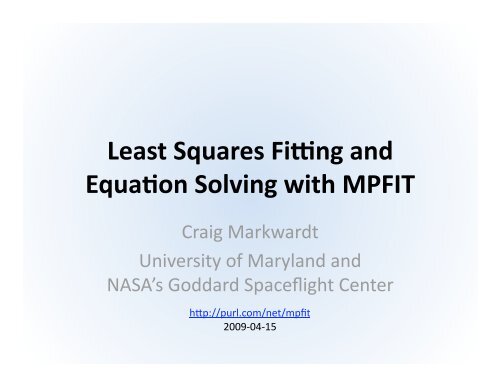

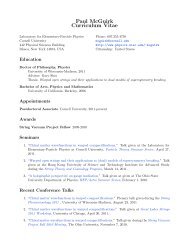

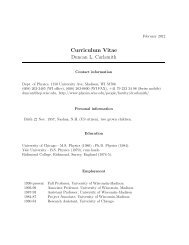




![The Symmetric Linear Potential [ ]](https://img.yumpu.com/25329322/1/190x245/the-symmetric-linear-potential-.jpg?quality=85)

